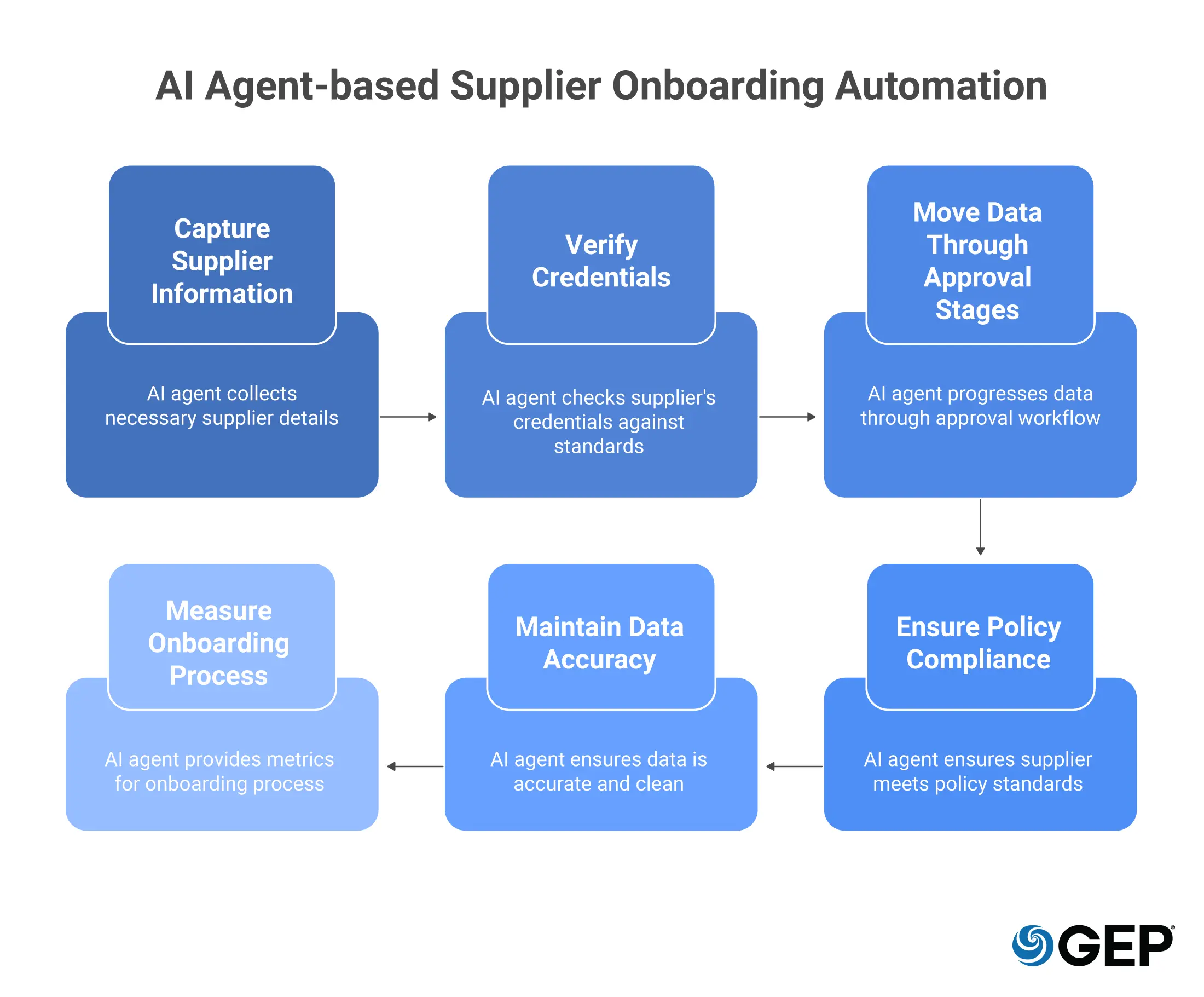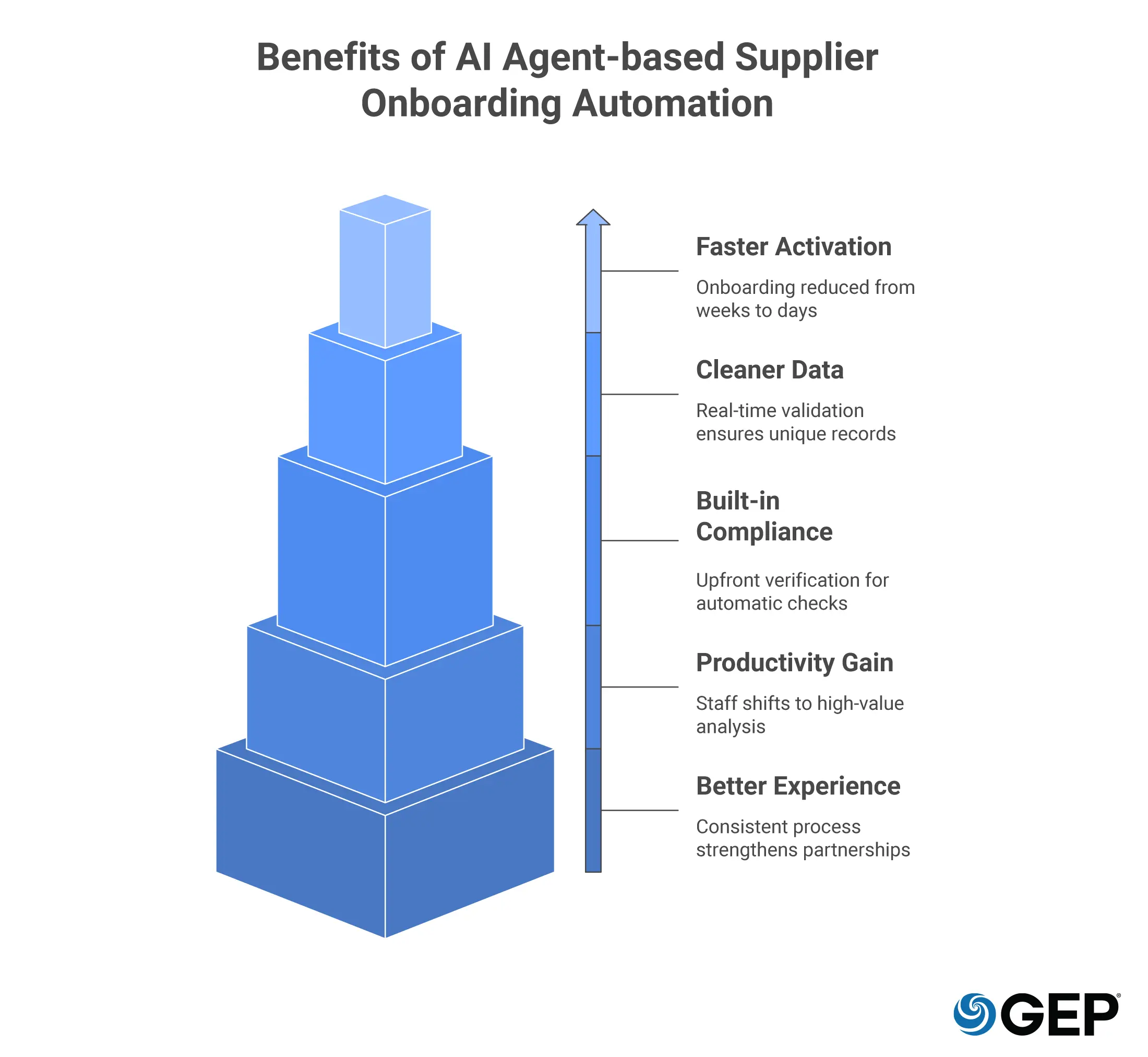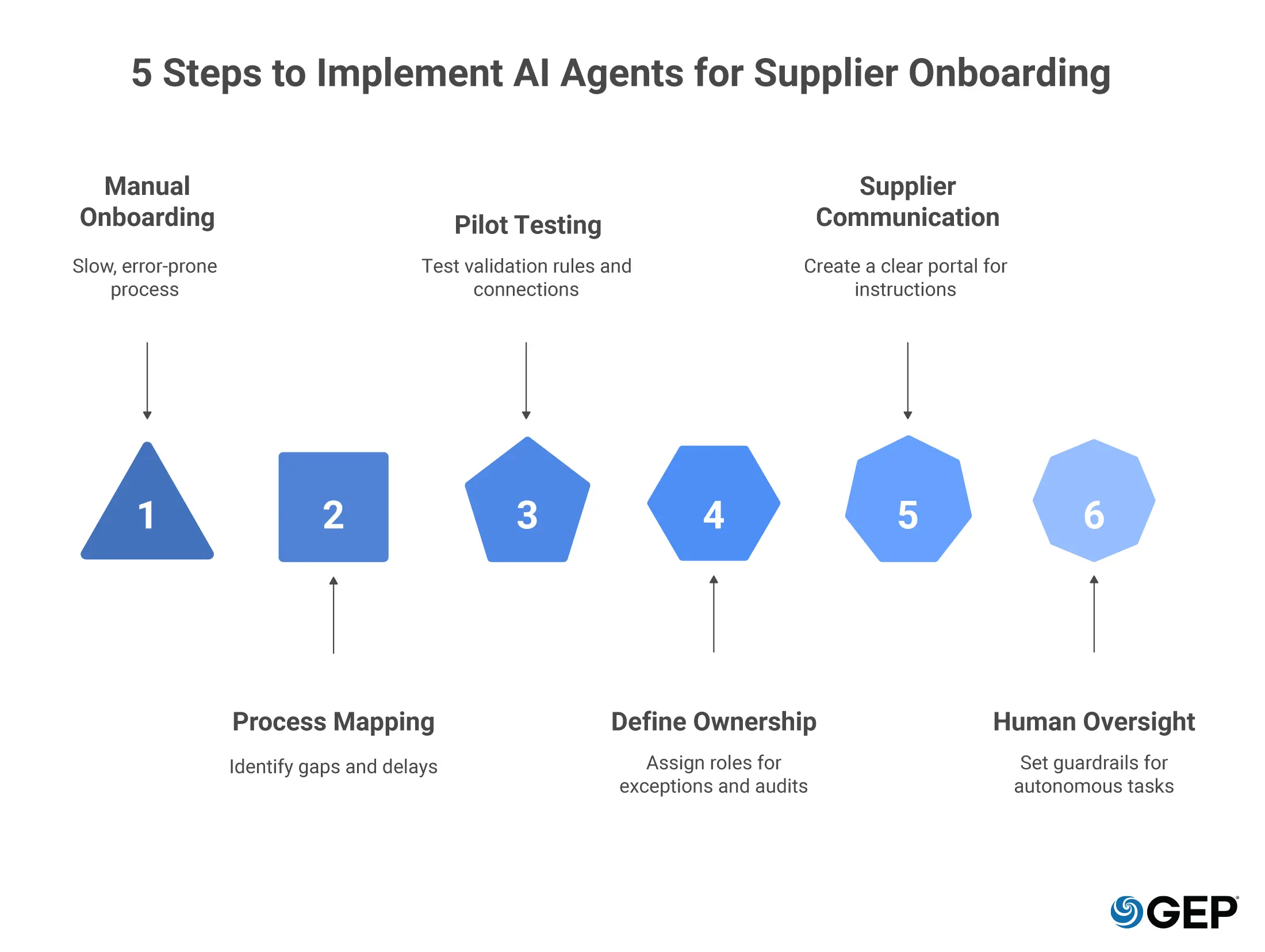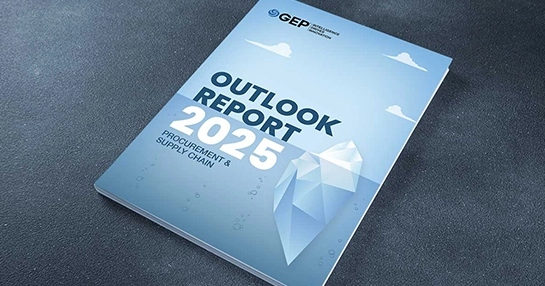
How to Implement an AI Agent to Expedite Supplier Onboarding?
- AI agents manage supplier intake end-to-end, verifying credentials, validating compliance, and flagging risks before approval.
- Every onboarding cycle is traceable, auditable, and continuously monitored for data integrity and compliance.
October 31, 2025 | Supplier Management Strategy 6 minutes read
Procurement leaders don’t usually struggle with strategy. They struggle with time. Onboarding a supplier can take weeks, and every delay costs more than patience.
AI agent-based supplier onboarding automation improves speed, accuracy, and visibility by scanning thousands of internal and external data points to identify risks, bottlenecks, and compliance gaps before they escalate. It gives onboarding teams a complete view of supplier performance and potential issues, all in one place.
What sets this approach apart from traditional automation is its independence. These systems don’t wait for someone to trigger an action. They gather the paperwork, verify what’s missing, move information through the right checks, and get better with every cycle. Over time, the process starts running itself with fewer slowdowns and far less noise.
But most organizations never get there. They stop at simple automations that copy, paste, and route forms, but don’t really understand the intricacies of the underlying process. Without clear metrics or visibility into risk, procurement teams lose track of where value leaks out and the butterfly effect begins.
Let’s look at how agent-based automation changes that equation: what it does differently, where it creates measurable impact, and how to put it to work inside a global supplier program.
The Case for Supplier Onboarding Automation
Manual onboarding has long been one of procurement’s slowest routines. Every team touches the same supplier file, creating overlaps, version conflicts, and long waits for approvals. It’s easy for something small to snowball into a compliance delay or a week of back-and-forth emails.
Those hours add up. Experienced employees end up managing paperwork instead of building supplier relationships or driving sourcing strategy.
That’s the real cost: lost focus on the strategic work that moves the business forward.
You also need end-to-end visibility of supplier progress to act fast. When suppliers and internal teams share a single, reliable view of where an onboarding request sits, you can spot and remove bottlenecks, shorten cycle times, and keep suppliers engaged. This preserves competition and flexibility across your supply base, whether you’re operating in the U.S., the Middle East, or globally.
That’s why automation, and specifically AI-driven automation with agentic capabilities, isn't optional but structural.
AI agents can organize validations, surface missing documents automatically, route exceptions to the right approver, and learn from failures so the process improves over time.
Automation makes the process faster and predictable. The result is speed, consistency, and control: fewer compliance hits, less rework, and more time for your team to focus on supplier performance and strategic decisions.
The Future Won’t Wait. Neither Should You.
Explore how agentic AI is reshaping procurement. Talk to an Expert
What is AI Agent-based Supplier Onboarding Automation?
AI agent-based supplier onboarding automates supplier intake from beginning to end. The agent captures information, verifies credentials, and moves data through each approval stage.
AI agents combine three vital aspects of onboarding:
● Operational: With a workflow that replaces repetitive onboarding tasks with intelligent automation.
● Strategic: Uses a control mechanism that ensures every new supplier meets policy, financial, and ethical standards before they transact.
● Technical: Combines multiple programs like Optical Character Recognition (OCR), Natural Language Processing (NLP), Machine Learning (ML), and Robotic Process Automation (RPA) to extract, validate, and record supplier data accurately.
AI agents cut manual effort, keep master data clean, and make supplier onboarding measurable, something you can finally control with precision.
Discover GEPs Suppler Management Software
How AI Agents Automate Supplier Onboarding
Supplier onboarding has long followed a predictable sequence: collect the data, check it, approve it, and file it away. In many organizations, those steps happen in silos, slowing progress and weakening control. AI agent-based automation connects them into a single, seamless flow.
- When a supplier enters tax numbers, certifications, or bank details, the system guides the process and flags missing information instantly.
- Once documents are uploaded, the software reads and organizes them to match internal data standards.
- During verification, the agent cross-checks each record against trusted databases, identifies duplicates or expired documents, and routes exceptions to reviewers.
- Clean, validated data then flows straight into your ERP or Source-to-Pay platform.
When automation works at this level, it changes more than just speed. It changes how your entire procurement function operates.
5 Benefits of AI Agent-based Supplier Onboarding Automation
With AI agents in supplier onboarding and management, you get a process that runs on its own but stays within your control. The human role shifts from “doing” to “deciding.”
1. Faster activation
You cut onboarding from weeks to days. Suppliers become active when you need them, not when the paperwork decides.
2. Cleaner data, fewer duplicates
Agents validate inputs in real time, ensuring each supplier record is unique and complete.
3. Built-in compliance
Verification steps happen upfront, so regulatory checks are automatic, not afterthoughts.
4. Productivity gain
Your staff moves from form-checking to high-value analysis. That’s real efficiency, not just automation on paper.
5. Better supplier experience
Vendors get a single, consistent process and faster feedback, which strengthens long-term partnerships.
Each benefit feeds the next. Faster onboarding means more reliable data; better data means fewer compliance issues. It’s an ecosystem that runs smoother because every piece reinforces another.
The New Playbook for Procurement Leaders
See how this new era of intelligence is transforming supply chains—and what leaders must do next.
How to Implement AI Agent-based Supplier Onboarding Automation
Getting it right starts with clarity, not software.
Find existing gaps
Map your current onboarding process before automating anything. See where handoffs slow down, approvals repeat, and data goes missing. You’ll often find most delays are actually process-related and not technical.
Test one pilot at a time
Pilot one supplier category or one geography and test validation rules, escalation paths, and ERP connections that do not risk large-scale system disruption.
Define clear ownership
Decide who manages exceptions, who audits the agent’s decisions, and who adjusts thresholds. Automation works best when governance is simple but firm. Use APIs wherever possible so agents interact with systems directly instead of through manual exports.
Keep suppliers informed
Create a simple portal with clear instructions and feedback loops. When vendors have a clear understanding of expectations, errors drop sharply.
Maintain Human Oversight
Start by setting guardrails. Define which tasks agents can complete autonomously and where human review is mandatory.
Log every action
Be it when certain data was verified, checked by whom, or through which system. This will help you backtrack when AI results go off the path.
Avoid blindsiding and overreliance
Humans should focus on judgment. Let machines handle repetition, but use your experts for calls that require nuance: assessing a high-risk vendor, interpreting a grey-area document, or deciding exceptions. That balance prevents automation from becoming blind execution.
Review, update, and reiterate
You’ll also need to review machine learning models periodically. Over time, data changes, regulations shift, and scoring logic must adapt. Schedule governance reviews as part of normal operations, not as a one-off event.
Good oversight turns automation from a black box into a reliable system of record. Keep your data clean, the rules and processes clear, and continuously test pilots. That’s what makes automation stick.
Why It Matters
At scale, supplier onboarding defines how fast your supply base can react. Companies that master it have a measurable edge with fewer compliance issues, faster sourcing, and more resilient supply chains. AI Agent-based Supplier onboarding automation makes that possible by embedding intelligence where work used to stall.
You can’t modernize procurement if supplier onboarding stays manual. Every delay ripples downstream: contracts wait, payments pause, and projects miss milestones. By automating the first step, you create a cleaner foundation for everything that follows.
Think of it as building muscle memory into your procurement process. Once trained, the system keeps going with minimal supervision.
The Takeaway
With AI agent-based supplier onboarding automation, you have a proactive, self-running system that enforces compliance, reduces manual work, and gives you real-time visibility. When done right, the payoff shows up fast through faster approvals, cleaner data, and smoother supplier relationships.
Need to integrate AI agent-based automation into your supplier onboarding process?
Explore GEP SMART™, a unified platform designed for enterprises that want to automate their Source-to-Pay cycle with intelligence, resilience, and measurable results. Built to handle disruption and market volatility, it gives procurement leaders better control over speed, accuracy, and spend visibility.
FAQs
Agents weave risk checks directly into the onboarding flow. This makes risk checks stop being an afterthought. The agent runs them as it goes by cross-referencing tax records, compliance filings, and even open-source news feeds without needing a new prompt. It builds a picture of each supplier from several sources and scores the overall risk. If something looks unusual, the agent pauses and pushes that case to your team for review. The same reasoning continues to function silently in the background once the supplier is operational. It tracks regulatory updates and news signals, sending an alert if anything changes that could affect compliance. So you don’t have to expand the risk team; your system stays aware and up to date on its own.






